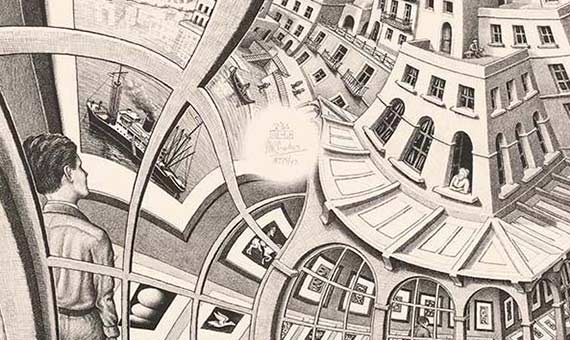A young man inside an art gallery is gazing at a picture of the seaport of Senglea, Malta. Among the buildings in the painting appears the art gallery in which the young man is standing, with the youth again looking at a picture of that same Mediterranean quay, in which, once again, the buildings appear with the art gallery and the young man. This infinite composition called Print Gallery is from the Dutch artist M. C. Escher (17 June 1898 – 27 March 1972). Escher also distorts this endless repetition, which bulges and twists, acquiring impossible shapes. The impact of the work would be perfect were it not for the white circular patch in the centre of the image, between the Mediterranean-style buildings and the gallery windows, a blank spot onto which Escher stamped his signature. The lithograph was finished. It was the year 1956. Almost fifty years would pass before a mathematician from the University of Leiden in Holland would manage to complete the work.

The first time that Professor Hendrik Lenstra came across Escher’s lithograph was in the inflight magazine on a flight from San Francisco to Amsterdam. Lenstra took advantage of the trip to try to find the solution to the centre of the puzzle. “I wondered whether if you continue the lines inward, if there’s a mathematical problem that cannot be solved?” he explained in an interview with The New York Times. “More generally, I also wondered what the structure is behind the picture: how would I, as a mathematician, make a picture like that?” The answer to these questions did not come during the hours of the flight, so Lenstra decided to embark on a two-year investigation, in which he discovered that unravelling the empty patch of Print Gallery was also to decipher Escher himself.
He was never an outstanding student
Maurits Cornelis Escher was never an outstanding student and his formal mathematical knowledge was limited to what he received in secondary school. He began studying architecture, but left to focus on his career as a graphic artist. Despite this theoretical deficiency, mathematics and geometry are key elements of his work. The Dutchman was so interested in concepts such as tessellation and the regular division of the plane —which he discovered in 1936 at the Alhambra in Granada, where he spent days carefully copying the geometric designs that decorate the palace— that they would become a central element of his work. Dozens of his engravings are filled with repetitions of animated figures whose spaces create new shapes.

Later on, Escher wondered if it would be possible to go a step further and fill the image with figures that, while keeping their shape and remaining fastened to each other, would change in size in a regular way. The solution of how to carry out these compositions was found in the mathematical article by H.S.M. Coxeter: Crystal Symmetry and Its Generalizations. From these scientific investigations —of which the artist himself acknowledged that he did not understand all concepts— Escher developed a knowledge of mathematics largely visual and intuitive.
In the next phase, his compositions began to explore errors of perspective in structures that, at first glance, seemed plausible, but upon closer inspection were impossible to create in reality. In 1954, some of his engravings were exhibited at the International Congress of Mathematicians in Amsterdam. From that time on, the dialogue that he maintained with mathematicians and crystallographers was a source of inspiration for his impossible compositions, his optical illusions and his representations of infinity.
Intersection between mathematics and the arts
This intersection between mathematics and the arts crystallizes in Print Gallery. In the lithograph, Escher defies the laws of perspective by creating an infinite and distorted repetition for which he had neither the means nor the calculations to complete. To decipher it, Professor Lenstra identified what is known as the Droste effect, named in honour of a famous advertising image of Dutch chocolate. If the art gallery where the young man is standing is reproduced again inside the painting, the same thing should happen within the white blob. After a conversation with Hans de Rijk, the friend of the artist and author of the book The magic mirror of M.C. Escher, Lenstra discovered that Escher had attempted to make a continuous circular expansion in the form of a closed ring, without beginning or end. Thus, in Escher’s distortion, the size of the squares of the grid grew as they moved from the centre outwards and they decreased in the opposite direction creating a loop similar to that which occurs when the plug is removed from a sink full of water. That was the structure behind the image.
In order to find the exact values that Escher had used in the distortion of his lithograph, Lenstra’s team spent months experimenting —even guessing— and combining rotations, exponential and logarithmic functions, along with reductions in size or scale. Once they had the exact formula, the steps needed to fill in the blank patch were straightforward thanks to modern technology. They used a computer program to remove the distortion in Escher’s drawing to convert it to a flat grid, filled the hole in the flattened image to complete the scene and, finally, returned it to its original shape by manipulating it with the distortion that they had already identified. Two years after that flight to Amsterdam, Lenstra and his team had solved one of the great mysteries from one of the most enigmatic artists. However, the answer had always been there; Escher was a genius, within a genius, within a genius…
Comments on this publication